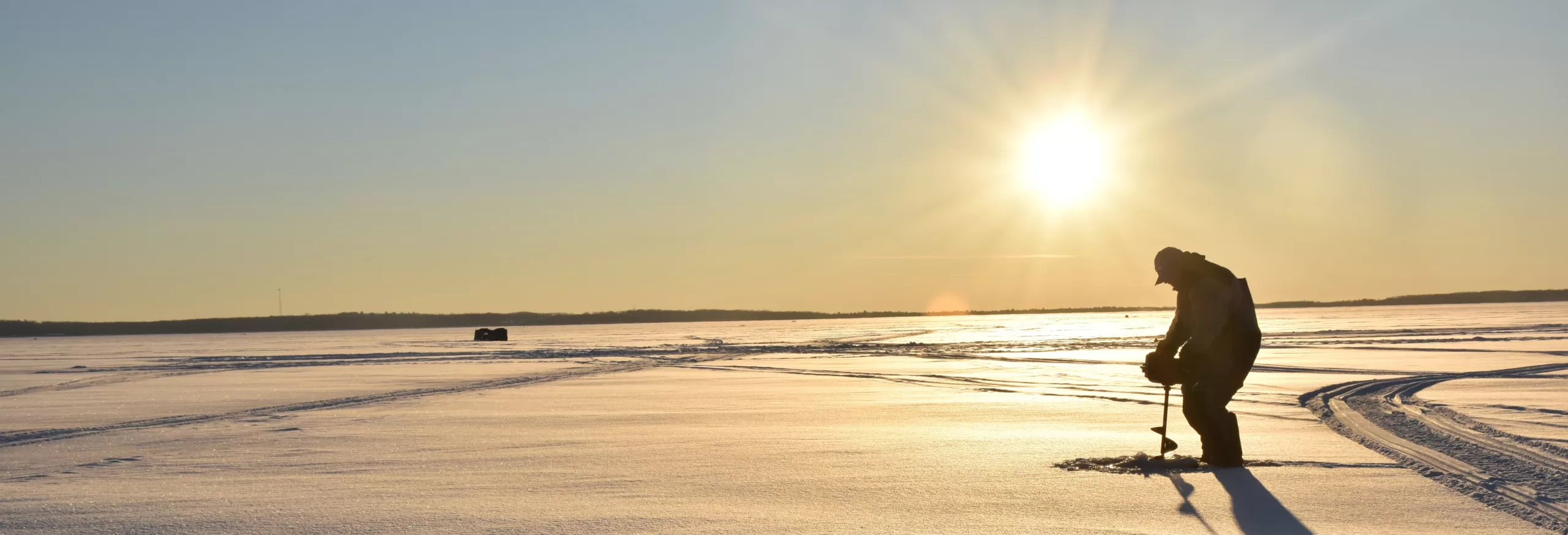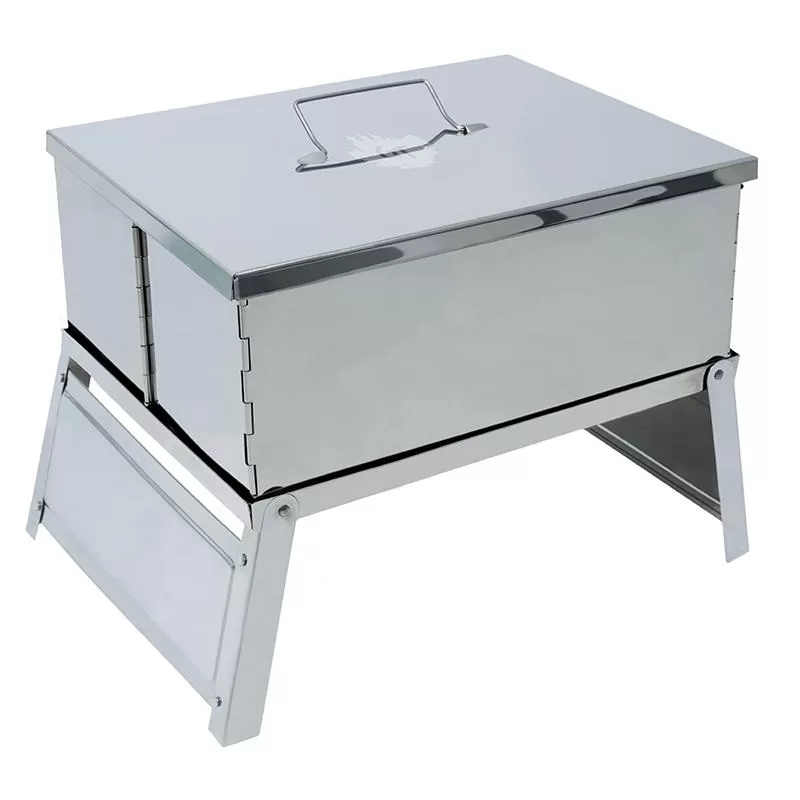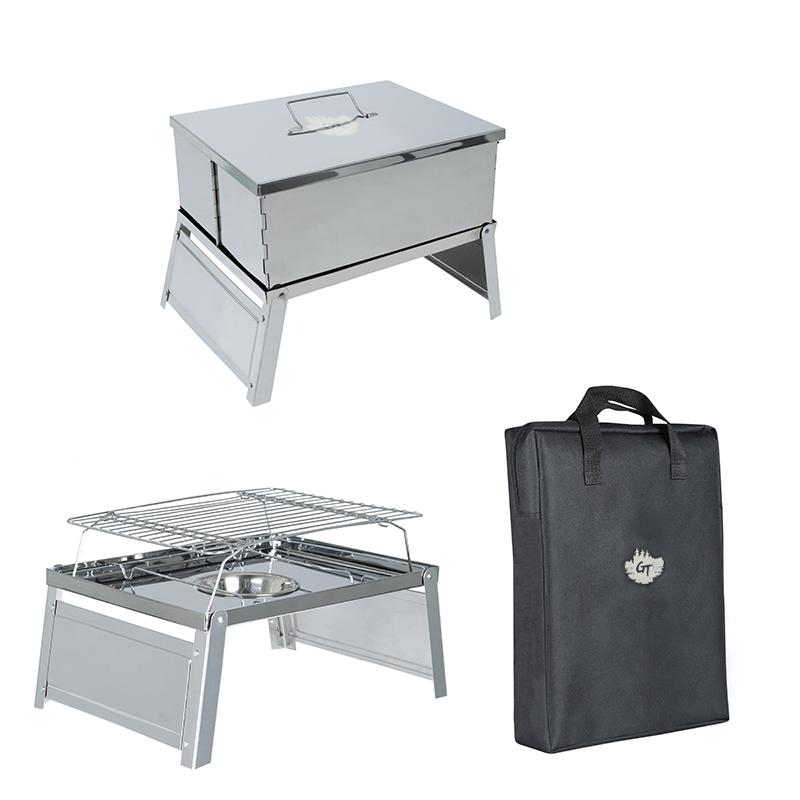For the die-hards, the true fanatics, the brave and/or the most masochistic of the gang, ice fishing can be done in the wild,
without the comfort of a wood-heated cabin! Properly prepared, you'll enjoy an extraordinary experience, in the heart of nature
and under special conditions. So, do you have what it takes?
1. Preparation, the key to success.
Planning this kind of activity is essential. You'll need to know where you want to go, how dangerous the site is, how thick the ice is,
and what's the safest way to prepare your surface for safe ice fishing.
You'll also need to prepare your tackle in advance, making sure you've got everything you'll need, so that once you're on the water,
in the middle of the woods, you don't have to turn back because you've forgotten something! So make a list of everything you'll need
(fishing gear, clothes, tools, food, transport equipment, map, plans, first-aid kit, etc.).
Bear in mind that your fishing equipment may vary depending on the fish you want to catch. It would be sad to miss out on some great fishing because you don't have the right rod, reel or lures...
Sonar can be an interesting tool to have with you. It will enable you to analyze your water surface, find out whether it's muddy or rocky,
how deep it is and where the fish are! With ice covering your surface, you won't be able to use your eyes as easily! So, this tool becomes interesting.
You'll also need to drill some holes. A hand drill (crankshaft) becomes necessary. But if you want to make life comfortable for yourself,
a battery-powered drill becomes a luxury! You'll be able to drill effortlessly, or almost, and change location at will.
Another good way to prepare for your trip is to walk your area the day before. This way, you'll be able to find the best spots, not only for fishing, but also for protection from the wind, cold and sun.

2. Identify potential hazards.
Ice moves, contracting and expanding continuously. On some bodies of water, pressure ridges can form, crack and refreeze. You need to pay close attention to these, as they can protrude and burst into the air. You must be extremely careful at all times, as the ice around these pressure ridges can be fragile and therefore dangerous. It may also be thinner in places and inconsistent.
Always make sure you have enough ice underfoot before venturing onto a frozen river. A number of websites will tell you which ice thicknesses are safe, and which rivers are suitable for this type of activity.
Avoid venturing onto any type of running water, whether it's a river mouth or frozen water bordering a dock where a de-icing system has been installed. After all, you want to have fun, not put yourself in danger!
3. Get up early, very early!
Yes, getting up super early pays off! As fish feed at dawn and dusk most of the time, these times of day are ideal for catching fish.
It's much nicer to get up at the crack of dawn when it's sunny outside, in the middle of summer, but you should know that sunrise over
a frozen expanse is particularly spectacular! That should encourage you! To make life easier, pack your bags the night before! All you have
to do is eat and go, without waking up the family, who will probably have chosen not to follow you on your icy adventure!
Since it's winter, the sun hasn't yet risen and you'll be setting up on a body of water, all safety measures must be followed to the letter.
Make sure you're dressed appropriately. This will help you avoid accidents, frostbite and other inconveniences associated with this
wonderful activity.
4. Dress in layers and stages.
Wilderness ice fishing often involves a long walk with all your gear in a sled. This physical effort is bound to make you sweat. And sweat means the risk of catching a cold, if you don't properly evacuate the moisture that accumulates around your body. So you need to take precautions
to ensure maximum comfort and safety.
Once you've arrived at your fishing site, drilled the holes and set up your shelter, you should move less, thereby lowering your body temperature. So pack dry clothes to add layers to your outfit. Above all, don't wear all your layers when you leave your starting point.
It's best to be prepared for the lake hike, unzip your coat and save your extra layers for when you arrive at your fishing spot. That way,
you can dress accordingly to the temperature and your level of warmth.
Remember to bring, in a separate bag, basic clothing made of synthetic insulating materials to keep you dry, rather than clothing that absorbs and retains moisture. The key for active anglers is to start with a good base layer and a set of moisture-repellent pants. This is followed
by a coat and snow pants, or a floater suit. Bring spare socks and accessories to keep dry!

5. Moving around.
When you're planning a wilderness ice-fishing trip, it often means that access to the site is undeveloped. So you'll need to find the best way
to get there. You may choose to combine several activities: cross-country skiing, pulling a sled filled with your gear, or Scandinavian sledding (like a dog sled, no dogs!), or snowmobiling! Whatever your preferred means of transport, be aware that you'll be carrying a lot of weight.
Try, of course, to bring only what you need. Avoid heavy items. Think light, high-performance materials. It will be more pleasant and less tiring.
If you choose to pull your luggage in a loaded boat, remember that lengthening the rope that pulls your sled is an excellent way of lightening the load. It's easier to pull and takes up less space than a short rope directly behind you. A great option for cross-country skiing. So get out there and be original!
6. Make yourself comfortable and enjoy!
Just because you're fishing in the wilderness doesn't mean you can't afford a modicum of comfort! You can set up a portable shelter to protect yourself from the wind. You can also build yourself a fire on the bank (respecting fire safety rules, of course) to keep warm from time to time. You can also wear polarized glasses to avoid the sun's glare, protective cream to avoid frostbite on your cheeks, a hat to hide your forehead from the sun and EVA tiles to cut the cold of the ice under your folding chair.
Look for every way to make your life enjoyable. You'll get hooked! And this fishing can be very sporty! If you're familiar with fishing techniques, you'll know how to imitate live bait and make beautiful trout want to fight!









